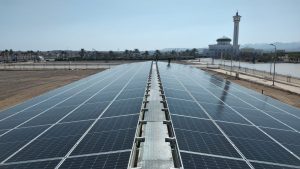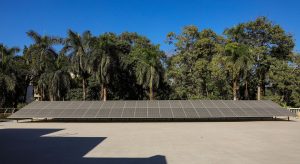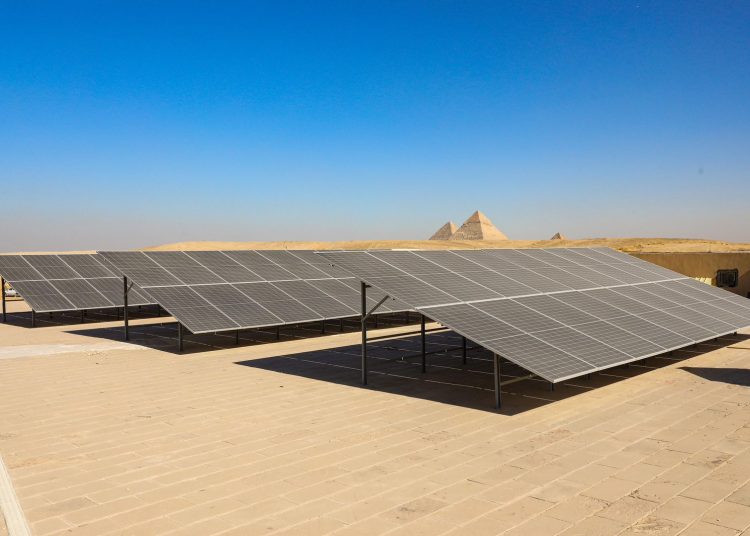Imagine how Prince Mohammed Ali Tewfik, heir presumptive of Egypt and Sudan in 1892-1899 and 1936-1952, would feel if he could see his palace in Manial today.
His elegant residence, which showcases his passion for art and culture, is now one of the five historic sites and museums in Egypt that will benefit from solar energy.
This is a great initiative to preserve the heritage and environment of these places, while also reducing their electricity costs. Mohammed Ali Tewfik would surely be proud of this achievement and happy to see his mansion shine with a new light.
Last week, from the Golden Hall of the palace came the announcement of the launch of solar power stations at five Egyptian world heritage sites and museums. The project is the result of collaboration between the Supreme Council for Antiquities (SCA), the Industrial Modernisation Centre, and the United Nations Development Programme (UNDP) in Egypt.
The project, known as Egypt PV, promotes sustainable energy practices and environmental conservation by installing rooftop small-scale PV systems.
These systems will provide clean and renewable energy to the sites and museums, reducing their dependence on fossil fuels and lowering their carbon footprint. The project will also create jobs and income opportunities for local communities, as well as raise awareness about the benefits of solar energy.
The Manial Palace, the Visitor Centre of the Giza Plateau, the Sharm el-Sheikh Museum and Alexandria’s National Museum and Royal Jewellery Museum will be examples of clean energy use.
The five solar power stations have a combined capacity of 325 kW of photovoltaic systems that produce 520 MW.hr/year of clean energy. This will help reduce greenhouse gas emissions by about 295 tons/year of carbon dioxide equivalent.
The Egypt PV project is supported by the Global Environment Facility (GEF) and later funded by the European Union through the UNDP project with COP27 Presidency. The project involved various government and private sector stakeholders and opened the market for rooftop small-scale PV systems in Egypt.
SCA Secretary-General Mostafa Waziry said the installation of solar power plants at world heritage sites and museums in Egypt will promote the use of solar energy for the country’s cultural heritage.

He said that the solar power stations are a strategic move to enhance sustainability and green energy practices in Egypt’s historical and archaeological treasures.
He added that this is in line with the Ministry of Tourism and Antiquities strategy, through the SCA, to make museums and archaeological sites green locations that rely on sustainable solar energy as a cost-effective alternative to electricity. He explained that this is consistent with Egypt’s Sustainable Development Strategy for 2030.
Ghada Shalaby, Vice Minister for Tourism Affairs, said the ministry is devoted to attaining sustainable growth while preserving the country’s invaluable heritage for future generations.
“We acknowledge the increasing global demand for responsible tourism and have actively participated with our stakeholders and partners such as the UNDP and UNWTO. Through these partnerships, we have endeavoured to implement sustainable technologies and foster cooperation between the government and the private sector in the tourism industry.”
She added that the heritage sites are more than just old buildings and monuments, but are part of Egypt’s rich history and culture. They also generate income and create jobs.
“We want to keep these sites in good condition for the future, which is why we use sustainable methods to manage them. This way, we can have a tourism industry that is good for both the locals and the visitors,” she said.
During the event, it was explained that the plan to install solar panels in cultural and historical places has two stages. The first stage covers 20 museums and archaeological sites that have been selected based on their suitability and feasibility. The second stage involves around six more museums and sites.
Doaa Selima, Executive Director of the Industrial Modernisation Centre, said the Centre provides consultancy services to the industrial sector, helping them to set up rooftop solar power stations as a way of using renewable energy.

She added that the Centre has technical expertise in this field, which it acquired through working with the Egypt PV project and UNDP. The Centre’s goal is to promote sustainable energy solutions for the industry.
UNDP Egypt Resident Representative Alessandro Fracassetti said that Egypt PV is a key project of UNDP’s support to Egypt’s energy transition and contributes to Sustainable Development Goals 7 and 13, as well as Egypt’s Vision 2023.
He added that the project aimed to increase the use of small-scale renewable energy systems and energy-efficient appliances to meet national NDC targets and renewable energy goals. This innovative initiative not only created opportunities for small-scale rooftop PV systems but also set the stage for a sustainable future.
“I hope the positive impact of this project encourages the replication of these efforts, providing green electricity to all historical sites in Egypt and demonstrating the potential of partnerships and innovation in achieving renewable energy goals.”
Hend Farouh, National Project Manager of Egypt-PV Project, said that due to the large efforts made by the project team members, the Grid Connected Small-Scale Photovoltaic Systems won the ElA Award which is the British Energy Institute award in 2020 as the best country in decreasing carbon emissions.
“We also won another award from International Finance Magazine, which is the best presenter for renewable green energy solutions,” she added.






Discussion about this post